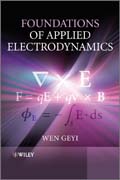
Foundations of Applied Electrodynamics takes a fresh look at the essential concepts and methods of electrodynamics as a whole, uniting the most relevant contemporary topics under a common mathematical framework. It contains clear explanations of high-level concepts as well as the mutual relationships between the essential ideas of electromagnetic theory. Starting with the fundamentals of electrodynamics, it methodically covers a wide spectrum of research and applications that stem from electromagnetic phenomena, before concluding with moreadvanced topics such as quantum mechanics. Includes new advances and methodologies in applied electrodynamics, and provides the whole picture of the theory of electrodynamics in most active areasof engineering applications. Systematically deals with eigenvalue problems, integral equation formulations and transient phenomena in various areas of applied electrodynamics. Introduces the complete theory of spherical vector wave functions, and presents the upper bounds of the product of gain and bandwidth for an arbitrary antenna. Presents the field approach to multiple antenna system, which provides a theoretical tool for the prediction of channel models of MIMO, and is also the basis of wireless power transmission system. One of the first books on electromagnetics that contains the general theory of relativity,which is needed in the design of mobile systems such as global positioning system (GPS). By summarising both engineering and theoretical electromagnetism in one volume, this book is an essential reference for practicing engineers, aswell as a guide for those who wish to advance their analytical techniques forstudying applied electrodynamics. INDICE: Chapter 1 Maxwell Equations. 1.1 Experimental laws. 1.2 Maxwell equations, constitutive relation, and dispersion. 1.3 Theorems for electromagnetic fields. 1.4 Wavepackets. Chapter 2 Solutions of Maxwell Equations. 2.1 Linear space and linear operator. 2.2 Classification of partial differential equations. 2.3 Modern theory of partial differential equations. 2.4 Method of separation of variables. 2.5 Method of Green’s function. 2.6 Potential theory. 2.7 Variational principles. Chapter 3 Eigenvalue Problems. 3.1 Introduction to linear operator theory. 3.2 Eigenvalue problems for symmetric operators. 3.3 Interior electromagnetic problems. 3.4 Exterior electromagnetic problems. 3.5 Eigenfunctions of curl operator. Chapter 4 Antenna Theory. 4.1 Antenna Parameters.4.2 Properties of far field patterns. 4.3 Spherical vector wavefunctions. 4.4Foster theorems and relationship between quality factor and bandwidth. 4.5 Minimum possible antenna quality factor. 4.6 Maximum possible product of gain and bandwidth. 4.7 Evaluation of antenna quality factor. Chapter 5 Integral Equation Formulations. 5.1 Integral equations. 5.2 TEM transmission lines. 5.3 Waveguide eigenvalue problems. 5.4 Metal cavity resonators. 5.5 Scattering problems. 5.6 Multiple metal antenna system. 5.7 Numerical methods. Chapter 6 Network Formulations. 6.1 Transmission line theory. 6.2 Scattering parameters for general circuits. 6.3 Waveguide junctions. 6.4 Multiple antenna system. 6.5 Power transmission between antennas. 6.6 Network parameters in a scattering environment. 6.7 RLC equivalent circuits. Chapter 7 Fields in Inhomogeneous Media. 7.1 Foundations of spectrum analysis. 7.2 Plane waves in inhomogeneous media. 7.3 Inhomogeneous metal waveguides. 7.4 Optical fibers. 7.5 Inhomogeneous cavity resonator. Chapter 8 Time-domain Theory. 8.1 Time-domain theory of metal waveguides. 8.2 Time-domain theory of metal cavity resonators. 8.3 Spherical waveexpansions in time domain. 8.4 Radiation and scattering in time domain. Chapter 9 Relativity. 9.1 Tensor algebra on linear spaces. 9.2 Einstein’s postulates for special relativity. 9.3 Lorentz transformation. 9.4 Relativistic mechanics in inertial reference frame. 9.5 Electrodynamics in inertial reference frame. 9.6 General theory of relativity. Chapter 10 Quantization of Electromagnetic Fields. 10.1 Fundamentals of quantum mechanics. 10.2 Quantization of free electromagnetic fields. 10.3 Quantum statistics. 10.4 Interaction of fields withsmall particle system. 10.5 Relativistic quantum mechanics. Appendix A. Set theory. A.1 Basic concepts. A.2 Set operations. A.3 Set algebra. Appendix B. Vector analysis. B.1 Formulas from vector analysis. B.2 Vector analysis in curvilinear coordinate systems. Appendix C. Special functions. C.1 Bessel functions. C.2 Spherical Bessel functions. C.3 Legendre functions and associated Legendre functions. Appendix D. SI Unit System. Bibliography. Subject index.
- ISBN: 978-0-470-68862-5
- Editorial: John Wiley & Sons
- Encuadernacion: Cartoné
- Páginas: 528
- Fecha Publicación: 21/05/2010
- Nº Volúmenes: 1
- Idioma: Inglés
